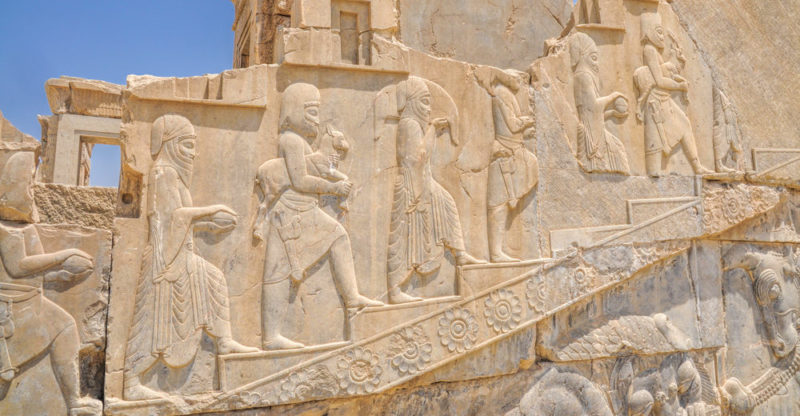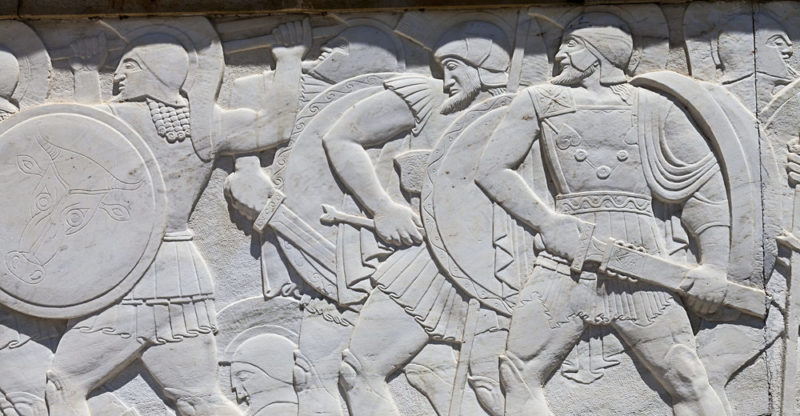We explain what the Persian Empire was, its formation and development. Also, what were its characteristics, culture, economy and more.
What was the Persian Empire?
The Persian Empire (also known as the Achaemenid Empire) was an empire that extended between 558 and 331 BC. C. from the current territory of Iran to Iraq, part of Egypt, Afghanistan, Pakistan, Armenia, Jordan, Turkmenistan, Oman, Turkey, Syria, Lebanon, Yemen, among some others.
The Persian Empire is considered one of the largest and most powerful in Asia , which managed to maintain itself thanks to its warlike power and its political administration. This empire developed great commercial power, in part due to the construction of highways, roads and bridges that allowed it to connect its territories that stretched from Asia to Africa . The Persian conquests towards the other towns were characterized by their religious tolerance and the acceptance and adoption of culture and traits of the conquered regions.
The fall of this empire occurred after the Persian attempts to take Greek territories and after the subsequent invasion of Alexander the Great , king of Macedonia, who conquered the Persians in 331 BC. C.
Formation and development of the Persian Empire

About 1400 a. C. the area of the Iranian plateau began to be inhabited by different nomadic groups from Russia that, over time, settled to form two large groups: the Medes, in the north, and the Persians in the south . The Persians were subject to the power of the Medes and were peoples that lived on livestock and agriculture.
In 559 a. C. Cyrus II (also known as "the Great") came to power from the Persians, and unified the peoples and rebelled against the Medes. Cyrus achieved Persian independence and conquered all the lands of the Medes . This conquest put an end to the Median rule over the Persian people and began the formation of the largest empire seen up to that moment.
After the conquest of the Medes, the Persians conquered more territories of Asia minor such as Lydia and Ionia and, in 539 BC. C. , they conquered the city of Babylon. After this conquest they allowed the Hebrew people, exiled in Babylon, to return to Jerusalem. Along with Babylon, the Persians conquered the area of Palestine, Syria, and all of Mesopotamia .
After the death of Ciro, the Persian power was in the hands of his son, Cambyses II, who was in command of the conquest of Egypt in 525 BC. The Persian Empire was characterized by its policies of openness to the conquered lands, since it allowed freedom of worship and freedom of government and administration in the annexed territories.
The maximum consolidation of the empire occurred in the reign of Darius I, king who was in charge of carrying out many of the works that allowed the interconnection and organization of the territories and the development of cities and palaces. During his reign the conquest of Greece was undertaken in what is known as the medical wars, which marked the beginning of the end of the Persian Empire.
Characteristics of the Persian Empire
Some of the main characteristics of the Persian Empire were:
- It was founded by King Ciro II, who defeated the Median King Astiages, in 550 BC. C.
- It expanded from the current territory of Iran (the area of origin of the Persians) through the territories of Afghanistan, Arabia, Egypt, Pakistan, among others.
- It was led by a king who was the absolute authority of the empire.
- It was one of the largest and most prominent empires in world history.
- It spanned approximately two hundred years and was led by the Achaemenid dynasty, represented by: Cyrus II, Cambyses II, Darius I, Xerxes, Artaxerxes I, Darius III, among others.
- Its capital was installed in Persepolis, considered one of the greatest emblems of the Persian civilization.
- It applied a policy of tolerance towards the conquered territories, in which respect for freedom of worship, political autonomy, and lower taxes, among other measures , stood out .
- Its territory was divided into satrapies that were connected to each other by means of bridges and roads.
- He excelled in trade and in the development of trade routes that made it possible to connect all the territories of the empire.
- Its culture took on traits and traditions typical of the conquered territories and was characterized by the development of architecture and art .
- He was overthrown by Alexander the Great in 331 BC. C.
Religion and culture of the Persian Empire

The Persian Empire was characterized by respecting the culture and traditions of the dominated regions and, in many cases, incorporated several of these customs. This allowed the Persian culture to become one of the richest in the region.
The Persians excelled in the construction of palaces , large walled buildings that used to be the home of emperors or nobles. The palace of Persepolis, located in the east of the country, was one of the most recognized and functioned as the capital of the empire. The Persian palaces were spread over the different conquered lands and were decorated with frescoes, mosaics and sculptures .
Regarding religion, the Persians professed Zoroastrianism , a religion that had been revealed by the Iranian prophet Zoroaster and that raised the worship of a supreme god: Ahura Mazda. It is also believed that they worshiped Mithra (the god equivalent to the god Apollo of the Greeks).
One of the main points of the Persian conquests was their great religious tolerance with the conquered peoples, so different types of beliefs and religions coexisted in the territory of the empire.
The Persians were noted for their burial ritual . After the death of a loved one, they did not bury him because they considered that the bodies contaminated the earth. The corpses, then, were left on stone structures and were eaten by carrion birds.
Politics and administration of the Persian Empire

The Persians were ruled by an emperor , who was the highest figure and absolute leader of the entire empire. This king had a personal army called "the Immortals", who defended him.
The policy of the empire was very tolerant regarding the division and political administration of the conquered lands. Many of the towns that were annexed to the empire lived in anarchy before the arrival of the Persians, so they welcomed this people willingly. This was the case with the Hebrews in Babylon or in Phoenician cities like Syria.
The territories of the empire were divided into satrapies (an organization that was established by King Darius I) that were led by a satrap who had autonomy for the management of the territory and only had to pay taxes to the empire. The Persian Empire was characterized by a general reduction in taxes and by the construction of roads and bridges that allowed the connection between the different territories that made up the empire.
Economy of the Persian Empire
The Persian people dedicated themselves to cattle ranching and agriculture within the fertile lands of the valleys . Much of the Iranian plateau had a desert-like climate and many of the conquests were driven by the need to search for new and better lands.
Because many of the conquered lands welcomed the Persian presence, this people was able to establish commercial ties with many peoples taking advantage of the privileged geographical location in which the empire was based, with connections to Asia, Europe and Africa.
Trade was at this time one of the most important activities for the Persians, who expanded and improved the ways to market products more efficiently and cover more markets. This favored the appearance of commercial caravans and new traders.
The persian army

The Persian army consisted of archers, cavalry, infantry, and a large shipping fleet , and its men were characterized by their marksmanship and skill. This made this army consolidate as one of the strongest and most numerous of the time, which allowed it to conquer neighboring towns.
Once the Persian Empire grew in size, the diversity of cultures and types of armies coalesced under Persian power made it difficult to develop a strong military organization and tactics.
The different armies were in charge of protecting their territories and were summoned in case of need, but, although they were numerous, they were not entirely organized . This led to the decline of the Persian Empire which, when attempting to annex the Greek territories, was unable to cope with the armies of the Greek polis and then the powerful Macedonian army led by Alexander the Great.
Within the Persian army the Immortals stood out, an infantry regiment made up of 10,000 men who were in charge, above all, of royal protection. This group consisted of the most experienced warriors who had to be Persians or Medes.
The fall of the Persian Empire

By 530 a. C. the Persian Empire already extended by Asia and Egypt, and the king Darío I had to face uprisings that developed in diverse territories. One of them was the Ionian revolt, carried out by the Greek territories of the Ionia region with the support of other Greek cities. This revolt was put down and ended with the devastation of the city of Miletus.
One of the main objectives that Darío I raised was the conquest of the rest of the Greek territories. At that time, Greece was organized into city-states that gradually grew in importance and power. The Persians invaded by sea, in what is known as the First Medical War, and conquered the Cyclades islands, but were later defeated by the Athenians at the Battle of Marathon (490 BC).
After the death of Darius I, his son, Xerxes I, assumed the Persian power , who wanted to continue with the idea of annexing the Greek territories. Thus began the second medical war in which the Hellenic peoples were victorious, in battles such as that of Salamis (480 BC).
After these successive defeats, Artaxerxes, son of Xerxes, and later the last king of Persia, Darius III, assumed power. By this time, Greece had been unified under the power of Macedonian Alexander the Great, who made the conquest of the Persian Empire his goal.
Alexander the Great invaded the Persian Empire and his conquest took place over three main battles: the Battle of Granicus (334 BC), the Battle of Issos (333 BC) and, finally, the Battle of Gaugamela (331 BC), in which the Persian Empire was defeated and Alexander was erected as the new king.
The above content published at Collaborative Research Group is for informational and educational purposes only and has been developed by referring reliable sources and recommendations from experts. We do not have any contact with official entities nor do we intend to replace the information that they emit.
Veronica is a culture reporter at Collaborative Research Group, where she writes about food, fitness, weird stuff on the internet, and, well, just about anything else. She has also covered technology news and has a penchant for smartphone stories. .
Leave a reply
Your email address will not be published. Required fields are marked *Recent post

Sport: What Is It, Types, Risks, Features, Characteristics and Examples

Dogs: Emergence, Features, Characteristics, Feeding and Breeds

Story: Definition, Elements, Structure, Features and Characteristics

